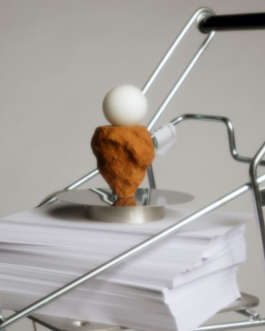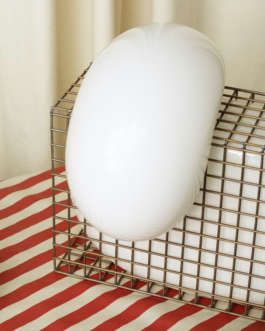



Jalkanen & Keski-Pomppu, Cypress Lighting Collection, 2024 © Sara Urbanski
COLLECTIBLE In-Depth
March 2024
This series, COLLECTIBLE In-Depth, unveils the backstage of contemporary creation. Tackling various topics from personal designer processes to the position of collectible design on the global design market, COLLECTIBLE In-Depth offers different views to suit all tastes. Today we talk to Piia Jalkanen & Päivi Keski-Pomppu founders of Jalkanen & Keski-Pompu.
COLLECTIBLE: Can you talk about a new piece / collection that you release for COLLECTIBLE this year?
Piia Jalkanen & Päivi Keski-Pomppu: A series of lights is created for The Collectible - fair, the focus is on local Finnish materials and in craftsmanship.
The lights are handcrafted from Finnish red clay and shaped into an organic shape. Each light is a unique individual piece. The clay comes from the neighboring village of Päivi Keski-Pomppu’s childhood home. The clay is worked by hand in Piia’s and Päivi’s own work space in Helsinki. The glass part was made in cooperation with a glassblower in a small village in Kiikoinen and Riihimäki.
The products are sculptural, and play at the interface between art and product.
C: How did you get into collectible design? Why did you focus your practice on this type of design rather than industrial design?
PJ & PKP: We have both received education in the field of design and interior architecture . As wonderful as the education is, it mainly focuses on industrial and mass production, which is also ok and part of our work. But for us, making by hand, craftsmanship, testing and working concretely with the materials seemed more natural. We also like to play at the interface between art and product, sculpt objects that have a function. This style of thinking and doing does not completely fit into the field of industrial design.
C: What makes design collectible in your eyes?
PJ & PKP: Limited series, individual unique products, experiment, crossover between the design and art and more. It also means that each piece is unique in their own way. Not all design objects need to be functional, and can in fact be purely decorative and appreciated for their aesthetic value. And the value in the work is not only in how it can be used, but in how the piece was created and its aesthetic.
C: If you were to collaborate with someone outside of the design scene, from another industry, who would you pick?
PJ & PKP: Artists and Sculptors would be a very obvious and meaningful partner. But we prefer to keep an open mind, because even surprising partners could bring some new insight into our own work. Working with old craftsmen has always been our big dream. But we have found ourselves working with people like florists or chemists, so we want to keep our mind open about this.
C: Where do you take your inspiration from?
PJ & PKP: Limiting inspiration is almost impossible, for better or for worse. The world around us and the things happening in the world affects us and our work, whether we like it or not. A big influence is art and subcultures like music, literature, sounds, people etc. And the roots of both are an important influence, which can be seen and heard in our work. We both come from the countryside, where as children we lived a simple life surrounded by family. From our grandparents, we learned a connection with nature and an appreciation for materials and craft culture, which has been preserved from generation to generation.
But inspiration is all around, as long you step out the door and keep an open mind.
C: How do you question or challenge functionality in your design process?
PJ & PKP: Furniture design education has always emphasized function, so challenging functionality is difficult. But we both also have a lot of art studies and have had the opportunity to freely experiment. Which has definitely helped to question the slavish following of function. Objects can also only be aesthetically pleasing or otherwise emotional for the user.

Jalkanen & Keski-Pomppu, Cypress Lighting Collection, 2024 © Sara Urbanski

Jalkanen & Keski-Pomppu, Cypress Lighting Collection, 2024 © Sara Urbanski
COLLECTIBLE In-Depth
March 2024

Jalkanen & Keski-Pomppu, Cypress Lighting Collection, 2024 © Sara Urbanski
This series, COLLECTIBLE In-Depth, unveils the backstage of contemporary creation. Tackling various topics from personal designer processes to the position of collectible design on the global design market, COLLECTIBLE In-Depth offers different views to suit all tastes. Today we talk to Piia Jalkanen & Päivi Keski-Pomppu founders of Jalkanen & Keski-Pompu.
COLLECTIBLE: Can you talk about a new piece / collection that you release for COLLECTIBLE this year?
Piia Jalkanen & Päivi Keski-Pomppu: A series of lights is created for The Collectible - fair, the focus is on local Finnish materials and in craftsmanship.
The lights are handcrafted from Finnish red clay and shaped into an organic shape. Each light is a unique individual piece. The clay comes from the neighboring village of Päivi Keski-Pomppu’s childhood home. The clay is worked by hand in Piia’s and Päivi’s own work space in Helsinki. The glass part was made in cooperation with a glassblower in a small village in Kiikoinen and Riihimäki.
The products are sculptural, and play at the interface between art and product.
C: How did you get into collectible design? Why did you focus your practice on this type of design rather than industrial design?
PJ & PKP: We have both received education in the field of design and interior architecture . As wonderful as the education is, it mainly focuses on industrial and mass production, which is also ok and part of our work. But for us, making by hand, craftsmanship, testing and working concretely with the materials seemed more natural. We also like to play at the interface between art and product, sculpt objects that have a function. This style of thinking and doing does not completely fit into the field of industrial design.
C: What makes design collectible in your eyes?
PJ & PKP: Limited series, individual unique products, experiment, crossover between the design and art and more. It also means that each piece is unique in their own way. Not all design objects need to be functional, and can in fact be purely decorative and appreciated for their aesthetic value. And the value in the work is not only in how it can be used, but in how the piece was created and its aesthetic.
C: If you were to collaborate with someone outside of the design scene, from another industry, who would you pick?
PJ & PKP: Artists and Sculptors would be a very obvious and meaningful partner. But we prefer to keep an open mind, because even surprising partners could bring some new insight into our own work. Working with old craftsmen has always been our big dream. But we have found ourselves working with people like florists or chemists, so we want to keep our mind open about this.
C: Where do you take your inspiration from?
PJ & PKP: Limiting inspiration is almost impossible, for better or for worse. The world around us and the things happening in the world affects us and our work, whether we like it or not. A big influence is art and subcultures like music, literature, sounds, people etc. And the roots of both are an important influence, which can be seen and heard in our work. We both come from the countryside, where as children we lived a simple life surrounded by family. From our grandparents, we learned a connection with nature and an appreciation for materials and craft culture, which has been preserved from generation to generation.
But inspiration is all around, as long you step out the door and keep an open mind.
C: How do you question or challenge functionality in your design process?
PJ & PKP: Furniture design education has always emphasized function, so challenging functionality is difficult. But we both also have a lot of art studies and have had the opportunity to freely experiment. Which has definitely helped to question the slavish following of function. Objects can also only be aesthetically pleasing or otherwise emotional for the user.

Jalkanen & Keski-Pomppu, Cypress Lighting Collection, 2024 © Sara Urbanski

Jalkanen & Keski-Pomppu, Cypress Lighting Collection, 2024 © Sara Urbanski
Contact
info@collectible.design
VIP PORTAL
EXHIBITOR PORTAL
PRIVACY POLICY
© 2025 Collectible
Contact
info@collectible.design
VIP PORTAL
EXHIBITOR PORTAL
PRIVACY POLICY
© 2025 Collectible